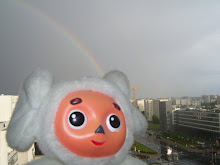2010 has been a banner year for Poland, and Warsaw in general. They broke new ground on the MoMA; Chopin is getting a year's-worth of celebration for his 200th birthday; the 600th anniversary of the Battle of Grunwald; the 66th anniversary of the Warsaw Uprising; and now, the 90th anniversary of the Miracle of the Vistula.
For those of you who did not know what the Miracle of the Vistula was: it was a decisive Polish victory over the Soviet forces in the Polish-Soviet War in 1920. On an interesting note: Charles De Gaulle served with distinction in this war (not too many non-Poles, non-De Gaulle fans know this.) Anyway, it was a huge victory for the Poles and their legendary leader, Jozef Pilsudski. It was kind of like the Polish Gettysburg, but only kind of. The greatly defeated Soviets soon sued for peace and the borders of Poland (which, at that time included Lwow and Wilno) remained intact until the German-Soviet invasion of 1939. The battle remains an important date in Polish history, except it happened in a war more forgotten than the Korean War. During the Communist times of Soviet hegemony, the Polish-Soviet War was covered over and hushed up much like the Warsaw Uprising (ask Norman Davies; he know firsthand of the matter.)
The war is a point of Polish pride in that it was the first major Polish military success in a couple of hundred years (and remains so) and that they defeated a much larger enemy to preserve their independence and freedom. The war, along with the Winter War (Russo-Finnish War), showed how terrible the Red Army really was. For those of you who would wonder why Germany would ever invade the Soviet Union, much smaller, much less powerful countries were able to embarrass the Soviets militarily.
Today, there was a commemoration of the battle at, most apt, Plac Pilsudskiego. There was also a big military fair in the Saxon Park (the Polish military's outreach to the public.) I stood around for some of the ceremony, involving ranks upon ranks of uniformed soldiers. Unfortunately, they blocked off Pilsudski Square, so the spectators couldn't really be close (except the VIPs.) The crowd wasn't that large, and the day was broiling, so I snapped a few film pictures (I don't have a digital camera right now.) So, I didn't stick around for the speeches, military drills, overtures, or displays, and I don't have any pictures beyond some black-and-white film pictures I took on a Zenit-E (an old Soviet model.)
Poland's sleeper train services: changes for 2026
-
With the new 2025/2026 railway timetable coming into effect today, there
have been significant expansions to Poland’s night-train network. Having
said th...
15 hours ago






4 comments:
Thank you for telling me that De Gaulle served in the war. My wife learnt this year that many Western Alliance Generals were there as advisers (with the young De Gaulle) at the battle, but she still thought only Poles fought in the war. Last year she learnt for the first time that Poles were among the military leaders on the Bolshevik side. Maybe we will learn more next year.
Thanks to your and others' inspiration I decided to try and produce something regular myself. I was planning on doing something on the Polish-Soviet War today, which was helped by your own and W-wa Jeziorki's comments. I would be very flattered if there was anything in the future that you might feel worth picking up on your own blog. See EnglishWarsaw
Hey, no problem. Thanks for reading my blog.
Yeah, European militaries were actually quite jumbled up back then. During WWII, (especially the Uprising), there were Polish military officers who were friends with the German and Austrian officers, depending if they had served in the German army or Austrian army (or even Russian army) pre-1918.
It is fascinating to learn about this important victory in Polish history.
Post a Comment